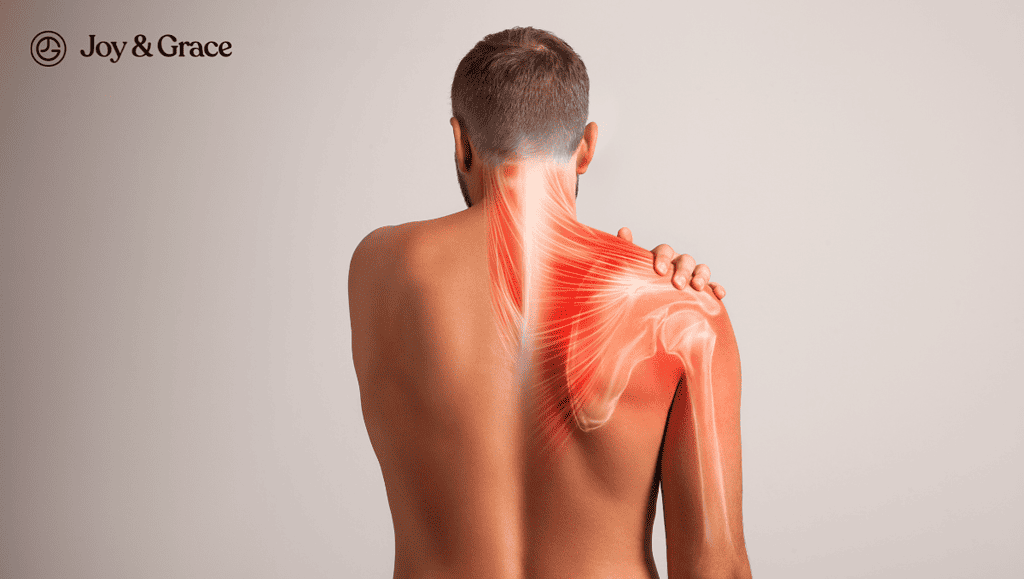Neck pain and its associated discomfort can make you yearn for a quick and accessible fix. This is the part where age-old heat therapy may come in handy! Can heat really do your neck pain good, and if so, how? What are the most effective ways to apply it? This article aims to settle these hot topics. So, let’s begin!
Is Heat Therapy Good for Neck Pain?
Yes, heat can be a good treatment option for neck pain. It’s an efficient and cheap way that may provide quick pain relief at home.
Heat therapy works by increasing the temperature of the skin and muscles. An increased temperature opens smaller blood vessels that send more blood to the painful region. It also increases metabolism and affects pain receptors. These effects lead to:
- Fewer pain signals to the brain
- Faster and better tissue healing
- More tissue elasticity
However, it's not always the best choice for everyone. Heat isn't advised in some instances, which we'll delve into later.
Additionally, while heat therapy may ease pain, it might not always be the best option to get rid of neck pain for good. Neck pain treatment may require a combination of therapies, which should be followed as prescribed.
As always, please consult your doctor before turning to heat therapies for neck pain.
What is the Best Heat Treatment for Neck Pain?
There are various available heat treatment therapies for neck pain. Some may be more effective for you than others. You can try them out and decide what works. Here are 10 of the best heat therapy modalities to consider.
1. Heating Pads: Is a Heating Pad Good for Neck and Shoulder Pain?
Yes, a heating pad can be beneficial against neck and shoulder pain. As its name suggests, a heating pad is a pad or compress that can provide warmth to a body region. Heating pads are available in three forms:
- Microwavable heating pads
These are often filled with materials like rice, grains, or special gels that retain heat. You heat them in the microwave for a specified amount of time, and then they can be applied to the painful area. They don't have adjustable settings, so you'll need to monitor the heat level and ensure they're not too hot before application.
- Electric heating pads
These pads use electricity to generate heat. Electric pads may have various heat settings. You can start with the lowest heat setting and adjust it as needed.
- Chemical heating pads
A chemical heating pad produces heat through a chemical reaction that happens inside the pad. This type of pad can be disposable or reusable.
- Hot water bottles or bags
These bottles or bags are traditionally made of rubber and filled with hot water.
Is It OK to Put a Heating Pad on the Neck?
Yes, you can put a heating pad on your neck. If you find the pad too warm, let it cool for a minute or place a cloth between the pad and your skin. This layer can be a simple, thin cloth or towel that doesn’t interfere with the function of the heating pad.
Can I Use a Heating Pad as a Warm Compress?
Yes. A heating pad is, in fact, a type of warm compress. It works by transferring heat when placed on the painful body region.
For How Long Should I Use a Heating Pad?
It’s recommended to use a heating pad for 15-20 minutes at a time.
It's okay to use a heating pad several times a day, with breaks in between. Don’t fall asleep or forget you’re using it, though! Overuse can lead to dangerous burns or skin irritation.
How to Choose a Heating Pad: What is the Best Neck and Shoulder Heating Pad?
At first glance, choosing the right heating pad type can seem daunting. There are so many options online. So, what should you look for? Consider these qualities:
- Heat source
Microwavable heating pads, often filled with grains or herbs, offer a convenient and portable solution for those seeking relief from aches and pains. They can be quickly warmed in a microwave and then applied directly to the affected area, providing heat and soothing scents in some cases.
They are portable and don't require a power outlet. You just need to microwave them for a few minutes, and they are ready to use.
In contrast, traditional electric heating pads are also a popular choice. They are easy to use and are widely available, offering consistent and adjustable heat settings to cater to individual needs. However, they need a continuous power source.
- Shape and size
The shape and size of the pad are also important to consider. A heating pad specifically designed for the neck and shoulders will fit better and provide more targeted heat.
- Heat settings
Choose a heating pad that makes it easy to find the perfect warmth. Everyone's heat tolerance varies. Thus, what’s comfortable or practical for one person may not be for another.
- Material and comfort
An ideal heating pad should be soft and comfortable against your skin, not scratchy or irritating. Many heating pads come with a washable cover, a bonus for hygiene and longevity.
2. Warm Wraps (Towel)
A hot or warm wrap is a compress that can work against neck pain. The easiest way to prepare a warm wrap is to use a towel. Dampen a towel with warm water and apply it directly over your neck region. Be careful not to use scalding water, as you might burn your skin.
According to a 2013 study, moist heat may be more effective for sore muscle relaxation than dry heat. Dry heat from sources like electric heating pads or infrared lamps raises the temperature without adding moisture. In contrast, methods using wet warmth, like warm towels, might provide better relief by introducing both heat and moisture.
3. Heat Gels and Creams
Topical heat gels and creams are often used for targeted relief from muscle aches and pains. When applied to the skin, these products create a warming sensation. This effect is often due to ingredients like capsaicin or menthol. The heat sensation can help increase blood flow to the area and reduce pain. Gels and creams are convenient, portable, and can be applied multiple times a day. It's always essential to follow the product's directions and avoid using them with other heat sources to prevent burns or irritation.
4. Hot Stone Therapy
This is a type of heat therapy that uses heated stones. Heated stones can be applied superficially to the skin, meaning you can simply put them on the neck region. Hot stone therapy can be combined with massage therapy to relax tense muscles.
5. Poultices
A poultice (also known as a cataplasm) is a soft, moist mass made from herbs or flour. Poultices are mainly used short-term for wounds, bruises, sprains, or strains.
Here’s a quick guide on how to prepare a simple poultice with fresh herbs at home:
- Determine which herbs you’d like to use. Beloved anti-inflammatory herbs include plantain, chickweed, calendula, dandelion, and burdock.
- Estimate how much you’ll need. The amount of herb depends on the size of the targeted neck area.
- Chop the herbs you’ve picked into small pieces on a cutting board.
- Transfer the herbs to a mortar and pestle and crush them until they become pulp. As you chop and mash, the herbs release their natural juices, and the leaves become softer. You can also use a blender instead of a cutting board.
- Spread the crushed herbs on your neck. Apply it evenly across the area.
- Wrap the area with a layer of gauze to hold the paste in place.
If fresh herbs aren’t available, you can try dried herbs! They can also work well. Take the desired dried herbs and moisten them with hot water. Add hot or cold water a little at a time to create a thick paste. Spread the paste evenly over the neck area and wrap with a gauze.
6. Paraffin Wax
Paraffin is a type of wax commonly used by physiatrists (PM&R specialists). When applied to the skin of the neck, paraffin can improve blood flow and loosen stiff joints. Consult your physiatrist to learn how to use paraffin.
7. Hot Baths
You might be a little too familiar with this one. A hot bath's steam and hot water can increase circulation and relax your neck muscles. Prepare your hot bath and soak your neck and body for 10-15 minutes
8. Sauna
A sauna is a method that may have the same effects on neck pain as a hot bath. We must thank the Finnish people for this one! If you’ve never used a sauna before, start with a period of 5-10 minutes and work up to around 20. The appropriate temperature for a sauna is up to you. Most people prefer temperatures between 150-175 degrees for a traditional sauna.
9. Infrared Heat Lamps
Infrared radiation (IR) is a type of radiation that certain heat lamps (or other hot objects) can emit. IR can also be applied in patches or even IR saunas. A 2022 study review shows that infrared radiation can be a potential therapy for musculoskeletal and chronic pain.
According to the study, IR may potentially have positive effects against pain in the following conditions:
- Fibromyalgia (a generalized health condition that causes body aches, tiredness, and trouble sleeping)
- Osteoarthritis (a disorder that causes joint degeneration)
- Sleep-related disorders
- Muscle and bone damage from athletic injuries
The study also reports no associated significant side effects. We suggest you consult your doctor before you undertake IR therapy.
10. Deep-Heat Therapy
Deep heat is produced when energy is converted into heat as it passes through body tissues. This conversion causes rapid increases in tissue temperatures, which can provide therapeutic effects for neck pain.
Energy can result from the following:
- Shortwave Diathermy: Uses high-frequency electric currents.
- Microwave Diathermy: Uses very high-frequency radio waves.
- Ultrasound Diathermy: Uses high-frequency sound waves.
- Inflammatory and degenerative conditions
- Tendonitis (inflammation of muscle tendons)
- Tenosynovitis (inflammation of the tendon sheath where muscles connect to bone)
- Bursitis (inflammation of the bursal sac)
- Osteoarthritis (degeneration of joints)
- Rheumatoid arthritis (autoimmune and inflammatory joint disease)
- Muscle spasms
- Injuries (muscle strains or sprains)
- Contractures and adhesion (deformities of rigidity of joints)
What is Best for Neck and Shoulder Pain, Heat or Cold?
According to a 2015 study, heat and cold can be beneficial for musculoskeletal pain in different ways. So, one may not necessarily always be better than the other.
Cold therapy (cryotherapy) may work better for acute neck and shoulder injuries. The benefits of cold therapy are greatest in the first 48-72 hours after an injury.
On the other hand, heat is preferred over cold in the following situations:
- Chronic neck and shoulder pain
- Sore neck
- Low back pain
- Delayed-onset muscle soreness (DOMS)
A 2020 research study shows heat therapy may also be used as trigger point therapy. The study shows heat can be applied to specific neck spots called trigger points. These spots are essential to pain development. Heat application may completely replace physical therapy or opioid medications in some people.
Is Heat Good for Nerve Pain in the Neck?
Nerve pain in the neck may arise from a medical condition called cervical radiculopathy. Cervical radiculopathy occurs when a nerve root coming out of the spinal cord gets pinched or compressed. As a result, you might feel the following symptoms along your neck, shoulder, and arm:
- Numbness
- Tingling
- Weakness
- Loss of sensation
So, yes, heat may temporarily relieve nerve pain in the neck. However, cervical radiculopathy usually calls for more thorough treatment. Seek your doctor’s opinion early on to achieve the best outcome.
Is Heat Good for Shoulder Pain?
Yes, heat can also relieve shoulder pain. Heat therapy may help with stiff shoulder joints and achy shoulder muscles. It can relax these structures by improving blood circulation.
Ensure you’re not using heat right after an injury, though. As mentioned, you’re better off using cold therapy (like an ice pack) for acute injuries.
Shoulder pain may have various causes, some more serious than others. An example of a more serious shoulder disorder is a rotator cuff tear. In such a case, heat therapy alone simply won’t do the trick. Make sure to consult your doctor if you have persistent shoulder pain that doesn’t get better with home remedies like heat therapy.
Is Heat on the Neck Safe?
Yes, heat therapy for neck pain is generally safe. Adverse effects from heat therapy are rare and minor. The most commonly reported side effect is “localized skin pinkness,” which usually goes away in a few hours.
Nevertheless, you should take the right measures before using heat therapy. Let’s see what these measures are.
How to Apply Heat Therapy for Effective Neck Pain Relief
As mentioned, you can easily use heat therapy at home. Proper use of heat therapy requires you to know the following ground rules beforehand:
- Don’t overheat.
Overheated modalities can damage the skin and cause burns.
- To ensure optimal comfort, modify the pad's warmth as needed.
You can easily adjust for electric and microwavable heating pads if it feels too toasty. Place a thin cloth or towel between the pad and your neck, change the settings if it's electric, or let it cool slightly if it's microwavable. Always take steps to ensure you're comfortable and safe.
- Make sure you follow instructions carefully.
For example, if you want to use a microwavable pad, place it on a plate before heating it in the microwave. After taking the plate out of the microwave, turn the microwave off. It might sound straightforward, but it's always best to be cautious to avoid any mishaps.
- Don’t fall asleep or forget about the pad.
Leaving a pad or wrap unattended can burn and damage your skin.
Heat therapy can be more effective when combined with other neck pain treatments, such as:
- Painkiller medications like Ibuprofen
- Physical exercise (neck exercises)
- Massage therapy, acupuncture, or yoga
- Lifestyle changes
When Not to Use Heat Therapy
The safety of heat therapy doesn’t imply it should be used every time you feel pain. Avoid using heat therapy:
- In the first 48 hours after an injury. By increasing circulation, heat can add to the ongoing inflammation from injury.
- If inflammation is the root of your pain. Pay attention to the red flags that signal inflammation. They go along with pain and include:
- Redness in the painful area
- Warmth
- Swelling
Additional care is necessary when applying heat therapy to patients with:
- Multiple sclerosis. Heat can exacerbate symptoms, as elevated body temperatures may worsen nerve function.
- Poor circulation. Impaired blood flow can make it difficult for the body to distribute the added heat. As a result, burns or tissue damage can occur.
- Spinal cord injuries. Reduced sensation may prevent the patient from telling when the heat is too intense. Consequently, burns, ulcers, and further damage can occur.
- Diabetes mellitus. Diabetes can cause nerve malfunction. Hence, diabetic patients might not be able to feel excessive heat. This can increase the risk of burns.
- Rheumatoid arthritis (RA). Excessive or prolonged heat might worsen inflammation in some individuals with RA.
Stop applying heat therapy if you have doubts or are unsure how to use it. Don’t hesitate to contact your healthcare provider for advice on how to proceed. This is the best way to prevent more severe damage.
Takeaway
Heat can be a good treatment option for neck pain.
Heat therapy works by increasing the temperature of the skin and muscles. An increased temperature elevates blood flow and metabolism. These effects lead to:
- Fewer pain signals to the brain
- Faster and better tissue healing
- More tissue elasticity
10 of the best heat therapy modalities include the following:
- Heating Pads
- Warm Wraps (Towel)
- Heat Gels and Creams
- Hot Stone Therapy
- Poultices
- Paraffin Wax
- Hot Baths
- Sauna
- Infrared Heat Lamps
- Deep-Heat Therapy
Heat is preferred over cold in the following situations:
- Chronic neck pain
- Stiff neck
- Low back pain
- Delayed-onset muscle soreness (DOMS)
Heat therapy may also be used as trigger point therapy.
In addition to relieving neck stiffness, heat can also serve as a pain reliever for shoulder pain. It may help with stiff shoulder joints and achy shoulder muscles.
Gentle heat therapy for neck and shoulder pain is generally safe. Adverse effects are rare and minor. The most commonly reported side effect is “localized skin pinkness.”
Proper use of heat therapy requires you to know the following ground rules beforehand:
- Don’t overheat.
- If the pad feels too hot, use an extra layer.
- Make sure you follow instructions carefully.
- Don’t fall asleep or forget about the pad.














